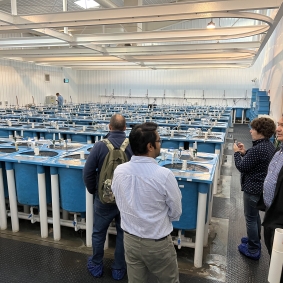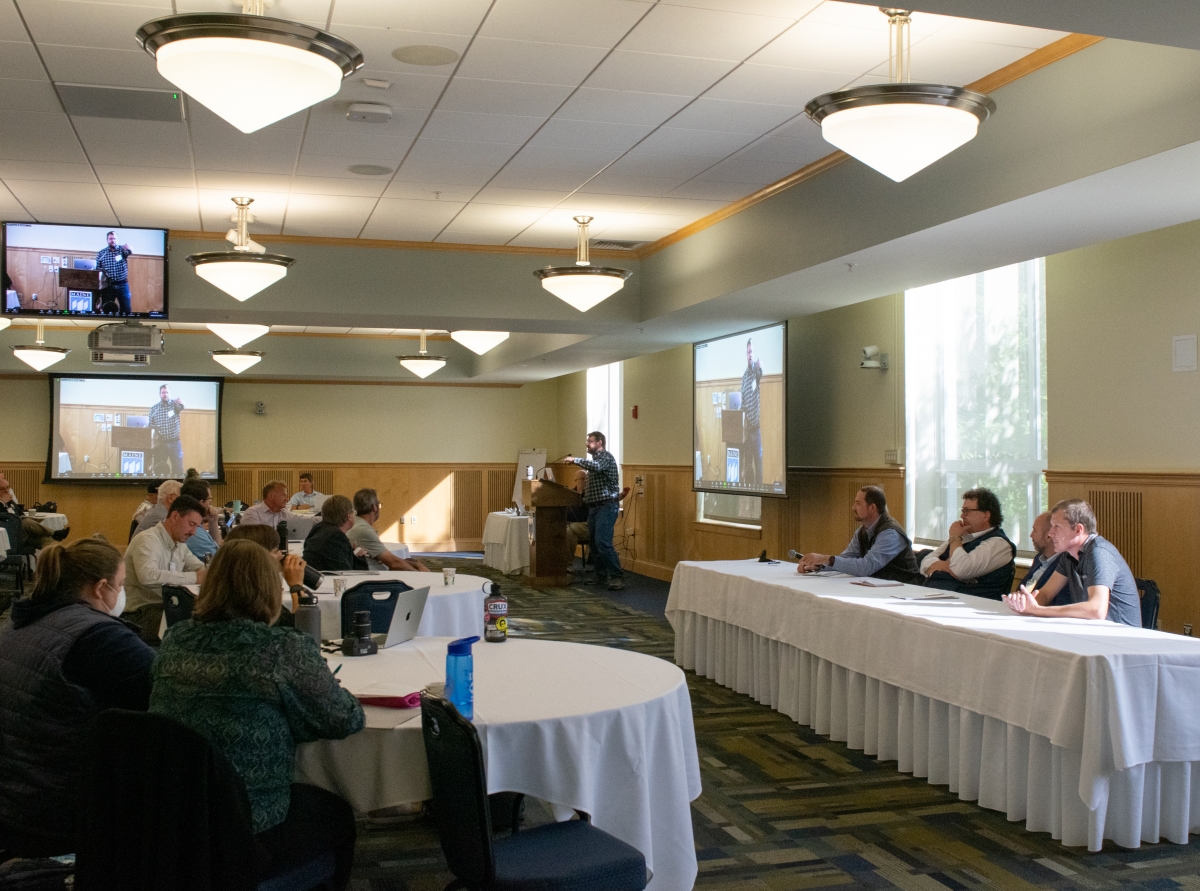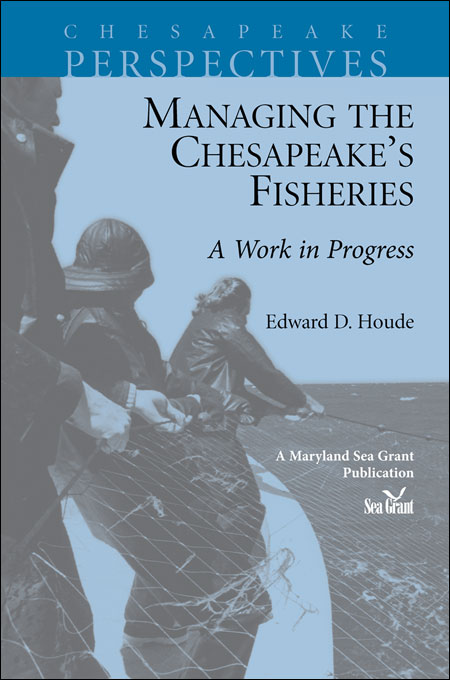Knauss legislative fellowships in Congress help build careers — and they're fun and educational. See our video and fact sheet for details.
Experts Convene to Discuss Land-Based Atlantic Salmon Aquaculture

Aquaculture experts from across the U.S., South Africa, Norway, and Iceland convened in Orono, Maine, for the third annual Recirculating Aquaculture Salmon Network (RAS-N) and first annual Sustainable Aquaculture Systems Supporting Atlantic Salmon (SAS2) conference on September 27, 2022. Over two and a half days, the 100 participants learned of new technologies, outreach strategies, and cutting-edge research for land-based production of Atlantic salmon in the United States through presentations, panel discussions, and field trips.
RAS-N started in 2019 with funding from the National Sea Grant Office for a three-year effort to build capacity and identify and address challenges. The multi-state consortium, led by partners in Maine, Maryland, and Wisconsin, is now transitioning into a new phase, SAS2, with $10 million in funding from the U.S. Department of Agriculture’s National Institute of Food and Agriculture, aiming to increase public awareness, and boost the economic and environmental sustainability of the industry.
Recirculating aquaculture systems (RAS), a farming method where water is pumped through treatment systems that clean and re-filter circulated water, allow finfish farmers across the country to use more efficient systems with less water and less environmental impact compared to other fish farming methods. While the network, RAS-N, focuses on Atlantic salmon, recirculating aquaculture systems support a wide variety of species, including trout, arctic char, shrimp, and sturgeon.
“Throughout the conference we heard from different panels spanning from workforce development to market to education, and how they are all linked to one another,” said Yonathan Zohar, Director of the Aquaculture Research Center at the Institute of Marine and Environmental Technology. “With two more years of funding, we need to think about these different groups and how to think across them to disseminate more information through networking and collaboration. It’s an exciting time for U.S. aquaculture development.”
Presentations at the September conference also covered technical challenges, such as fish health, and fish feeds, and the security of salmon seedstock. Scalability, improving efficiencies and regulations, and improving general knowledge and understanding emerged as key themes.
“Using genomics and metabolomics, we learn more about the quality of eggs and develop noninvasive predictors for broodstock quality that are scalable, fast, and inexpensive,” Heather Hamlin, director of the University of Maine School of Marine Science and Aquaculture Research Institute, explained during a session on seedstock.
Research and development of a domestic seed supply would be extremely beneficial for the U.S. as RAS gains more traction, because most of the current seedstock comes from outside the country. Similarly, research to create more efficient feeds exemplifies how research and technology can help the RAS industry overcome the challenges it faces.
John Davidson of the Freshwater Institute in West Virginia communicated research focusing on biological mechanisms for characterization and control of RAS microbiomes to understand how the fish’s environment influences its flavor, and new advanced oxidation techniques. Sarah Cook from Skretting, the world's largest producer of fish feeds, discussed the physical aspects of feed impacts to the recirculating systems as a whole.
“It’s important to look at each individual system and work with farms to understand how their system works, because all systems are so different,” Cook said. Both Davidson and Cook’s research further demonstrate the effort to enhance RAS in the U.S. and the importance of meaningfully working with the industry and across sectors.
Day two of the conference focused on the human dimensions of aquaculture: community engagement, understanding social license to operate, and workforce development.
Placing RAS in classrooms and developing modules for aquaculture curriculum with tech integration and hands-on science could increase science literacy and the skills that go along with it—beneficial for the workforce of the future.
“Developing standards or competencies is needed on a national level,” said Scarlet Tudor, education and outreach coordinator at University of Maine’s Aquaculture Research Institute. “We need people with different educations and backgrounds, and we need to start them young.”
Programs like Aquaculture in Action, led by Maryland Sea Grant Assistant Director for Education Adam Frederick, provide teachers with aquaculture tanks, fish, and water quality monitoring software for their classrooms.
"Placing RAS in classrooms and increasing the science literacy skills that go along with it is invaluable," Frederick said. "We want to create a positive association with the word aquaculture for kids through hands-on science, as they're the workforce and clientele of the future."

It was also evident from these sessions that successful development of RAS education programs and material should integrate traditional ecological knowledge and engage with indigenous knowledge sharers. Co-creating curriculum through the Wabanaki Youth in Science Program (WaYs) is one example of providing youth with education other than Western science, enhancing and decompartmentalizing their views. Through WaYs, Maine Native youth (grades 6-12) have the opportunity to participate in science while engaging with their cultural heritage through summer camps, internships, and after school programs.
Alongside other presentations focused on social license and market research, Wisconsin Sea Grant Food Fish Outreach Coordinator Sharon Moen shared lessons she has learned from the "Eat Wisconsin Fish" program that are relevant to salmon aquaculture.
"A lot of my job is looking at Wisconsin: who in Wisconsin is eating fish, where they live, how they think, and what they spend their time on," Moen explained. "Just understanding peoples' barriers to the product is really important. You have to understand the problems before you can overcome them."
At the end of the second day, a closing talk from University of New Hampshire Ph.D. Candidate Emily Whitmore highlighted the importance of community engagement.
“Relational elements between a company and a host community are vital,” said Whitmore. “Consulting, trust building, and building support instead of rebutting opposition will set you up for success.”
King Fish USA, for example, faced opposition, but gathered ongoing approval from the community, and it paid off for the company when the Town of Jonesport rejected an aquaculture moratorium earlier this summer.
“RAS is the most viable path for growth in the U.S.,” said Erik Heim from Xcelerate Aqua. “Improving time to market, keeping revenue on schedule, costs on budget, and improving environmental stewardship is key.”
Further coordination after the conference will help with tech transfer, advancing research, and involving multiple disciplines in the RAS workforce. As the network grows through the USDA grant, continued communication between disciplines and a focus on education, as well as diversity, equity, and inclusion, will support the RAS industry and influence sustainable food production systems.
This news release was adapted from a news release from the University of Maine.
Contact: Corinne Noufi, corinne.noufi@maine.edu




